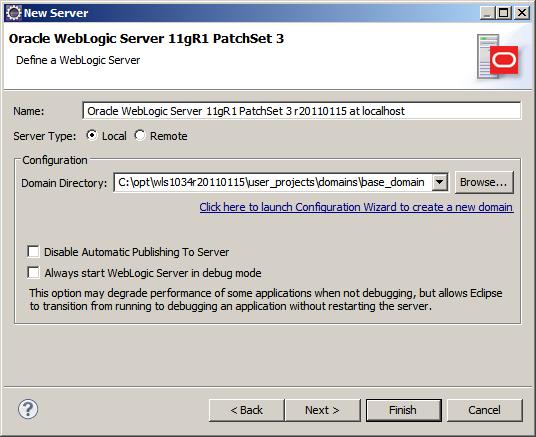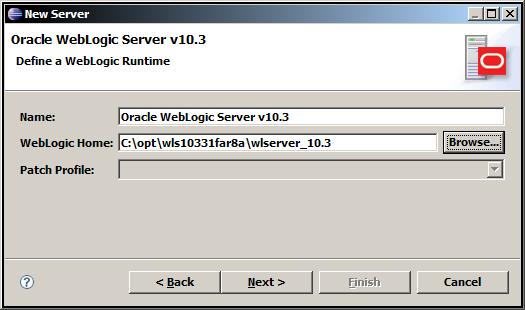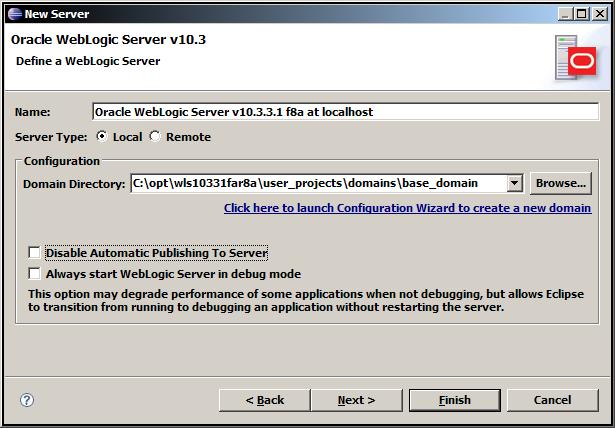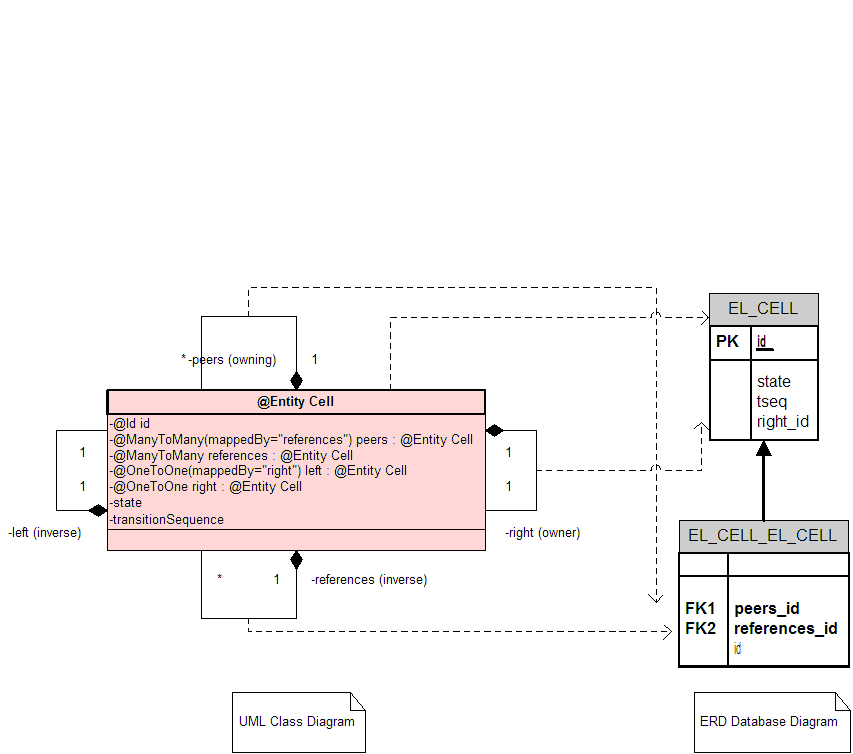Notice: this Wiki will be going read only early in 2024 and edits will no longer be possible. Please see: https://gitlab.eclipse.org/eclipsefdn/helpdesk/-/wikis/Wiki-shutdown-plan for the plan.
EclipseLink/Examples/JPA/WebLogic Web Tutorial
Contents
- 1 EclipseLink JPA Deployed on WebLogic 10.0/10.3 using Eclipse WTP
- 1.1 Tutorial Source
- 1.2 Development Environment
- 1.3 Prerequisites
- 1.4 WebLogic configuration Changes
- 1.5 JNDI Datasource Setup
- 1.6 EclipseLink JAR location
- 1.7 JDBC JAR location
- 1.8 Create server in Eclipse
- 1.9 Create J2EE application
- 1.10 Persistence.xml
- 1.11 Start Server
- 1.12 Publish EAR
- 1.13 Perform a JPQL query
- 1.14 Troubleshooting
- 1.15 References
EclipseLink JPA Deployed on WebLogic 10.0/10.3 using Eclipse WTP
If you want to get a small web application running quickly on WebLogic - the services provided by the Web Tools Project plugin in the Eclipse IDE can take care of the deployment details and set the server into debug mode for you.
This basic example details how to use Eclipse to run/debug a minimum J2EE web application servlet using EclipseLink JPA as the persistence provider. The goal of this example is to detail the minimum steps needed to run EclipseLink inside WebLogic using the Eclipse IDE - at this point no presentation/controller layer such as JSF, Spring or Struts will be used beyond a basic HttpServlet so we can concentrate on the the integration layer JPA setup.
Tutorial Source
The EAR, EJB and Web Eclipse project source for this EclipseLink WebLogic tutorial is available online at the following locations. These 3 projects must be imported along with the jpa core eclipselink project.
- Checkout the following 3 projects together from $trunk/examples.
- org.eclipse.persistence.example.jpa.server.weblogic.enterpriseEAR
- org.eclipse.persistence.example.jpa.server.weblogic.enterpriseEJB
- org.eclipse.persistence.example.jpa.server.weblogic.enterpriseWeb
- EclipseLink source via SVN committer access
svn+ssh://user@eclipse/svnroot/rt/org.eclipse.persistence/trunk
- EclipseLink source via SVN anonymous access
svn://dev.eclipse.org/svnroot/rt/org.eclipse.persistence/trunk
The following link will put you at the root of the SVN tree using the online version of subclipse.
And the DDL generation J2SE JPA application used to populate the database schema.
Development Environment
Hardware: Windows Vista SP1, HP Core2Quad, 2.4Ghz, 3Gb Ram
Software: Eclipse IDE for Java EE 3.4 M5 Ganymede (Feb 2008) with all 5 packages (DTP 1.6, EMF 2.4, GEF 3.4, WTP 3.0, XSD 2.4), Oracle 11g DB 11.1.0.6.0, SUN Java JDK 1.6.0_07, WebLogic 10.3.3.1
This example will run fine with Eclipse 3.3 EE and any Database that EclipseLink supports.
Prerequisites
Install Eclipse EE
- I installed a clean version of Eclipse Ganymede 3.4 RC2 EE edition with all of WTP 3.0
- I modified the eclipse.ini file parameters
Install a Database
- In this example I am using Oracle 11g, the table schemas have already been created manually and all entity java classes have been generated using the Eclipse DALI tool.
Install Oracle WebLogic Server
- Oracle WebLogic Server 10.3 on OTN Oracle WebLogic Server 10.3
- WEBLOGIC_HOME=C:/bea/wlserver_10.3
Install Oracle WebLogic Server Tools for Eclipse
- Eclipse 3.3/3.4 EE does not come with the WebLogic server configurations out of the box, however you can add it from eclipse with the following steps, you must in order to pick up the 10.x server plugins.
- In Eclipse goto the link "Download additional server adapters"
- Note: The bea-wls-tools-2.0.2 plugin works only up to Eclipse 3.4 Ganymede M5 (not the later RC(n) versions) - this plugin site has been deprecated.
WebLogic configuration Changes
JNDI Datasource Setup
Global Scoped Datasource Setup
- You may update config.xml directly - not recommended, or use the admin console wizard to create your JNDI datasource.
- wls10n/user_projects/domains/base_domain/config/config.xml will contain the following new entry where OracleDS-nnnn-jdbc.xml will contain all the DB properties parameters.
<jdbc-system-resource> <name>OracleDS</name> <target>AdminServer</target> <descriptor-file-name>jdbc/OracleDS-0429-jdbc.xml</descriptor-file-name> </jdbc-system-resource>
Application Scoped Datasource Setup
If you require the use of an application scoped/deployed datasource, please refer to the following documentation on how to setup and reference an application scoped datasource on WebLogic 10.3.
When using JPA you will only require 1 of the 5 custom weblogic descriptors - weblogic-application.xml described below.
Your oracle-jdbc.xml will require an Application scope.
<jdbc-data-source-params> <jndi-name>appDS</jndi-name> <scope>Application</scope>
Your persistence.xml will require both <jta-data-source> and the fully qualified "javax.persistence.jtaDataSource" property defined - override behavior is described in bug# 246126.
<persistence version="1.0" xmlns="http://java.sun.com/xml/ns/persistence" xmlns:xsi="http://www.w3.org/2001/XMLSchema-instance" xsi:schemaLocation="http://java.sun.com/xml/ns/persistence http://java.sun.com/xml/ns/persistence/persistence_1_0.xsd"> <persistence-unit name="unified" transaction-type="JTA"> <provider>org.eclipse.persistence.jpa.PersistenceProvider</provider> <jta-data-source>appDS</jta-data-source> <properties> <property name="javax.persistence.jtaDataSource" value="java:app/jdbc/appDS"/>
EclipseLink JAR location
- It is not recommended that you distribute eclipselink.jar with your EAR application.
Option 1: Leave shipped module as is - Recommended
- EclipseLink now works out of the box in WebLogic 10.3.3.1
- As of WebLogic Server 10.3.3.1 the EclipseLink library is shipped in the following location on the server. You may use this version unless you would like to override the jar with a different version in options 2-4 below
- $WEBLOGIC_HOME/modules/org.eclipse.persistence_1.0.0.0_1-0.jar
Option 2: eclipselink.jar on domain
To get the server to automatically pick up eclipselink.jar during startup - it should be placed off of $WEBLOGIC_HOME/samples/domains/wl_server/lib
Or if you have created your own default user domain put the jar into the following directory
$WEBLOGIC_HOME/user_projects/domains/base_domain/lib
You will see the following on startup
<Sep 3, 2008 11:22:56 AM EDT> <Notice> <WebLogicServer> <BEA-000395> <Following extensions directory contents added to the end of the classpath: C:\opt\wls103a\user_projects\domains\base_domain\lib\eclipselink.jar; C:\opt\wls103a\wlserver_10.3\platform\lib\p13n\p13n-schemas.jar; C:\opt\wls103a\wlserver_10.3\platform\lib\p13n\p13n_common.jar; C:\opt\wls103a\wlserver_10.3\platform\lib\p13n\p13n_system.jar; C:\opt\wls103a\wlserver_10.3\platform\lib\wlp\netuix_common.jar; C:\opt\wls103a\wlserver_10.3\platform\lib\wlp\netuix_schemas.jar; C:\opt\wls103a\wlserver_10.3\platform\lib\wlp\netuix_system.jar; C:\opt\wls103a\wlserver_10.3\platform\lib\wlp\wsrp-client.jar; C:\opt\wls103a\wlserver_10.3\platform\lib\wlp\wsrp-common.jar>
Option 3: eclipselink.jar specified at startup
If you do not want to reference eclipselink.jar outside of the WebLogic install then you must modify the startup script that was generated for your domain.
see $C:\opt\wls103a\user_projects\domains\base_domain\bin\startWebLogic.cmd:85.
Note: I haven't preserved anything that may already been set on weblogic.ext.dirs - we should append the eclipselink.jar with a path delimiter - however this web application predeploys and runs fine with the following path addition instead of using option 1 above.
set JAVA_OPTIONS=%JAVA_OPTIONS% -Dweblogic.ext.dirs=c:\eclipselink.jar
See the updated classpath and predeploy logs
<Sep 3, 2008 11:39:40 AM EDT> <Notice> <WebLogicServer> <BEA-000395> <Following extensions directory contents added to the end of the classpath: C:\eclipselink.jar; C:\opt\wls103a\wlserver_10.3\platform\lib\p13n\p13n-schemas.jar;C:\opt\wls103a\wlserver_10.3;.....C:\opt\wls103a\wlserver_10.3\platform\lib\wlp\wsrp-common.jar> .... [EL Finest]: 2008.09.03 11:39:55.497--ServerSession(32263885)--Thread(Thread[Thread-20,5,Pooled Threads])--Begin predeploying Persistence Unit unified; state Initial; factoryCount 0
Option 4: eclipselink.jar on server - not recommended
If using multiple domains you may put eclipselink.jar higher in the classloader tree by dropping it into (TBD - test scenario required).
- Jar additions to $WEBLOGIC_HOME/wlserver_10.3/server/lib are not automatically picked up by the server.
- Jar additions to $WEBLOGIC_HOME/user_projects/domains/base_domain/config/lib are not automatically picked up by the server and require configuration.
JDBC JAR location
Jars for Oracle 11, MySQL 5 and Sybase 5.5/6.0 are off their own directories in
$WEBLOGIC_HOME/wlserver_10.[0|3]/server/ext/jdbc
Create server in Eclipse
- Open the servers view in the Java EE pane
- Select the WebLogic 10.3 server that is already defined or downloaded in the update step above.
New | Server | Oracle | WebLogic 10.3.
- Or Open the servers view for WebLogic 10.3
New | Server | "Download additional server adapters" for the latest 10.3 plugin for Ganymede 3.4
Create J2EE application
Create your own J2EE Enterprise Application as below. File | new | project | J2EE | Enterprise Application Project Select server, use 5.0 Ear version
Create a new Web and an optional EJB project
Select generate deployment descriptor if you want to change the context-root
- Path changes
<classpathentry combineaccessrules="false" kind="src" path="/org.eclipse.persistence.core"/> <classpathentry combineaccessrules="false" kind="src" path="/org.eclipse.persistence.jpa"/> or <classpathentry combineaccessrules="false" kind="src" path="/eclipselink.jar"/>
- After EAR project creation - reference the org.eclipse.peristence.core and jpa projects or include a reference to eclipselink.jar in your WAR project.
- If you don't reference the eclipselink.* projects then include a classpath reference to persistence.jar and an Oracle (or other Database) JDBC driver jar for your DB - You will need to put this JDBC driver jar in your WebLogic /domains/wl_server/lib directory as well.
Data Model
The following single entity Cell has a @ManyToMany bidirectional relationship to itself.
Tutorial Design
The goal of the tutorial is to demonstrate a quick start end-to-end deployment on a specific application server of an EclipseLink JPA application. To accomplish this...
- The web framework is a simple servlet so we avoid container specific issues around JSF implementation.
- The data model is very simple (@ManyToMany) - as the other tutorials get into more advanced JPA entity concepts and annoations
- The entitymanager is container managed where possible by injection
- The schema is generated by DDL generation in a separate common application
managed SE app.
- The application context name is standard across servers
- The datasource is globally defined (by the user) on the server - with the only configuration setting being the jta-data-source element in persistence.xml
DDL/Schema Generation
- The database schema for this example can be automatically generated using the DDL generation capability of EclipseLink (normally only used by development or for demos). The following project in SVN can be run as an application managed stand-alone JPA project that has ddl-generation turned on in the persistence.xml.
- http://dev.eclipse.org/svnroot/rt/org.eclipse.persistence/trunk/examples/org.eclipse.persistence.example.jpa.server.common.ddlgen
- Note: DDL Generation is not possible on a container managed entity manager connected to a JTA datasource - hence the use of a separate project that is server agnostic and sharable by all the JPA Web application tutorials in this section of the Wiki.
Persistence.xml
- JTA : Put persistence.xml beside your JPA entities in yourProjectEJB/ejbModule/META-INF
<persistence version="1.0" xmlns="http://java.sun.com/xml/ns/persistence" xmlns:xsi="http://www.w3.org/2001/XMLSchema-instance" xsi:schemaLocation="http://java.sun.com/xml/ns/persistence http://java.sun.com/xml/ns/persistence/persistence_1_0.xsd"> <persistence-unit name="unifiedWebLogic" transaction-type="JTA"> <provider>org.eclipse.persistence.jpa.PersistenceProvider</provider> <jta-data-source>OracleDS</jta-data-source> <non-jta-data-source>OracleDS</non-jta-data-source> <properties> <property name="eclipselink.target-server" value="WebLogic_10"/> <property name="eclipselink.logging.level" value="FINEST"/> </properties> </persistence-unit> </persistence>
- RESOURCE_LOCAL : non-JTA : Put persistence.xml beside your JPA entities in yourProjectEJB/ejbModule/META-INF
<persistence version="1.0" xmlns="http://java.sun.com/xml/ns/persistence" xmlns:xsi="http://www.w3.org/2001/XMLSchema-instance" xsi:schemaLocation="http://java.sun.com/xml/ns/persistence http://java.sun.com/xml/ns/persistence/persistence_1_0.xsd"> <persistence-unit name="unifiedWebLogic" transaction-type="RESOURCE_LOCAL"> <provider>org.eclipse.persistence.jpa.PersistenceProvider</provider> <properties> <property name="eclipselink.target-server" value="WebLogic_10"/> <property name="eclipselink.logging.level" value="FINEST"/> <property name="eclipselink.jdbc.driver" value="oracle.jdbc.driver.OracleDriver"/> <property name="eclipselink.jdbc.platform" value="org.eclipse.persistence.platform.database.oracle.OraclePlatform"/> <property name="eclipselink.jdbc.url" value="jdbc:oracle:thin:@localhost:1521:orcl"/> <property name="eclipselink.jdbc.user" value="user"/> <property name="eclipselink.jdbc.password" value="pw"/> </properties> </persistence-unit> </persistence>
Start Server
- Steps: Select the EAR and [Run on Server].
- The first "Run on Server" may not start the server, in this case you "Start Server" and then "Run on Server".
Publish EAR
- Publishing to WebLogic 10 is very simple (you don't require an IDE like Eclipse), once the server is setup you can just drop/remove an EAR in the autodeploy directory to domains/wl_server/autodeploy an application. Or use Eclipse to debug via the 5005 port if the server is managed through WTP.
- Eclipse WTP will take care of copying the EAR file to the live deploy directory when you either [re-publish] or modify any files while the server is running.
- You may also use any combination of running the WebLogic server yourself in run or debug mode and using eclipse to publish EAR changes.
- Depending on your application you will see the following predeploy/deploy logs after running [start server]
- In your console window you will see one process both for the server and the deploy target.
starting weblogic with Java version: BEA JRockit(R) (build R27.3.1-1_CR344434-89345-1.5.0_11-20070925-1628-windows-ia32, compiled mode) [EL Finest]: 2008.05.21 15:54:03.251--ServerSession(7692289)--Thread(Thread[[ACTIVE] ExecuteThread: '0' for queue: 'weblogic.kernel.Default (self-tuning)',5,Pooled Threads])--Begin predeploying Persistence Unit unifiedWebLogic; state Initial; factoryCount 0 [EL Config]: 2008.05.21 15:54:04.048--ServerSession(7692289)--Thread(Thread[[ACTIVE] ExecuteThread: '0' for queue: 'weblogic.kernel.Default (self-tuning)',5,Pooled Threads])--The alias name for the entity class [class org.eclipse.persistence.example.unified.business.StatLabel] is being defaulted to: StatLabel. [EL Finer]: 2008.05.21 15:54:04.188--ServerSession(7692289)--Thread(Thread[[ACTIVE] ExecuteThread: '0' for queue: 'weblogic.kernel.Default (self-tuning)',5,Pooled Threads])--Class [org.eclipse.persistence.example.unified.business.StatLabel] registered to be processed by weaver. <May 21, 2008 3:54:11 PM EDT> <Notice> <WebLogicServer> <BEA-000331> <Started WebLogic Admin Server "examplesServer" for domain "wl_server" running in Development Mode>
Perform a JPQL query
- At this time you can exercise your application in a browser by requesting a JPQL query - notice the use of the JTA datasource.
- http://127.0.0.1:7001/enterprise/FrontController
- This url command gets a container managed EntityManager via @EJB injection of the ApplicationServiceLocal Stateless Session Bean which contains an EM reference.
public class FrontController extends HttpServlet implements Servlet { @EJB(beanName="ApplicationService") public ApplicationServiceLocal applicationService; ... @Local public interface ApplicationServiceLocal { ... @Local @Stateless public class ApplicationService implements ApplicationServiceLocal { @PersistenceContext(unitName="example") private EntityManager entityManager; ...
Console Output
[EL Finest]: 2008.05.21 15:58:30.112--ServerSession(7692289)--Thread(Thread[[ACTIVE] ExecuteThread: '1' for queue: 'weblogic.kernel.Default (self-tuning)',5,Pooled Threads])--Weaved persistence (PersistenceEntity) [org.eclipse.persistence.example.unified.business.StatLabel]. [EL Info]: 2008.05.21 15:58:30.798--ServerSession(7692289)--Thread(Thread[[ACTIVE] ExecuteThread: '1' for queue: 'weblogic.kernel.Default (self-tuning)',5,Pooled Threads])--EclipseLink, version: Eclipse Persistence Services - 1.0 (Build SNAPSHOT - 20080507) [EL Info]: 2008.05.21 15:58:30.798--ServerSession(7692289)--Thread(Thread[[ACTIVE] ExecuteThread: '1' for queue: 'weblogic.kernel.Default (self-tuning)',5,Pooled Threads])--Server: WebLogic Server 10.0 MP1 Thu Oct 18 20:17:44 EDT 2007 1005184 [EL Fine]: 2008.05.21 15:58:31.985--Thread(Thread[[ACTIVE] ExecuteThread: '1' for queue: 'weblogic.kernel.Default (self-tuning)',5,Pooled Threads])--Detected Vendor platform: org.eclipse.persistence.platform.database.oracle.Oracle10Platform [EL Config]: 2008.05.21 15:58:32.016--ServerSession(7692289)--Connection(8272442)--Thread(Thread[[ACTIVE] ExecuteThread: '1' for queue: 'weblogic.kernel.Default (self-tuning)',5,Pooled Threads])--connecting(DatabaseLogin( platform=>Oracle10Platform user name=> "stat" datasource URL=> "jdbc:oracle:thin:@localhost:1521:orcl" [EL Finest]: 2008.05.21 15:58:33.061--UnitOfWork(9354744)--Thread(Thread[[ACTIVE] ExecuteThread: '1' for queue: 'weblogic.kernel.Default (self-tuning)',5,Pooled Threads])--Execute query ReadAllQuery(org.eclipse.persistence.example.unified.business.StatLabel) [EL Fine]: 2008.05.21 15:58:33.093--ServerSession(7692289)--Connection(8318645)--Thread(Thread[[ACTIVE] ExecuteThread: '1' for queue: 'weblogic.kernel.Default (self-tuning)',5,Pooled Threads])--SELECT ID, DATE_STAMP FROM STAT_LABEL WHERE (ID < ?) bind => [200] [EL Finest]: 2008.05.21 15:58:34.544--UnitOfWork(9354744)--Thread(Thread[[ACTIVE] ExecuteThread: '1' for queue: 'weblogic.kernel.Default (self-tuning)',5,Pooled Threads])--Register the existing object org.eclipse.persistence.example.unified.business.StatLabel@96976d
Browser Output
The following screen capture of this quickstart JEE WebLogic JPA application shows a visual representation of the entities persisted to the Oracle database using the EclipseLink JPA implementation on Oracle WebLogic Server 10.3
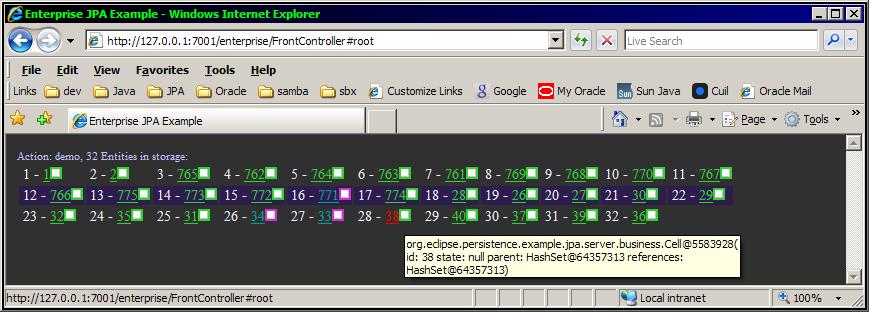
Troubleshooting
- If you get a "domain locked" popup error in eclipse when publishing your ear - delete the following lock file in your server domain
- $WEBLOGIC_HOME\user_projects\domains\base_domain\edit.lok
References
- See Integrating EclipseLink with an Application Server in the ELUG
- See Developing JPA Projects in the EclipseLink User's Guide.
- JMX MBeans for WebLogic Design Specifications [235168] [248748]
- JMX MBean Tutorial for WebLogic
- http://dev.eclipse.org/svnroot/rt/org.eclipse.persistence/trunk/examples/org.eclipse.persistence.example.jpa.server.weblogic.enterpriseEAR
- http://dev.eclipse.org/svnroot/rt/org.eclipse.persistence/trunk/examples/org.eclipse.persistence.example.jpa.server.weblogic.enterpriseEJB
- http://dev.eclipse.org/svnroot/rt/org.eclipse.persistence/trunk/examples/org.eclipse.persistence.example.jpa.server.weblogic.enterpriseWeb

